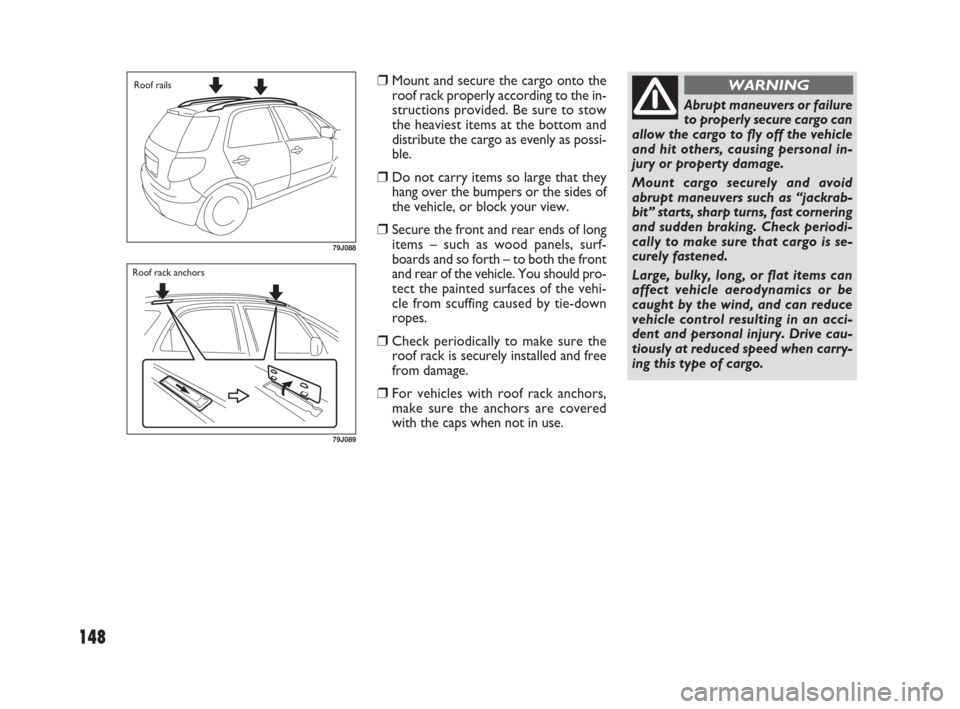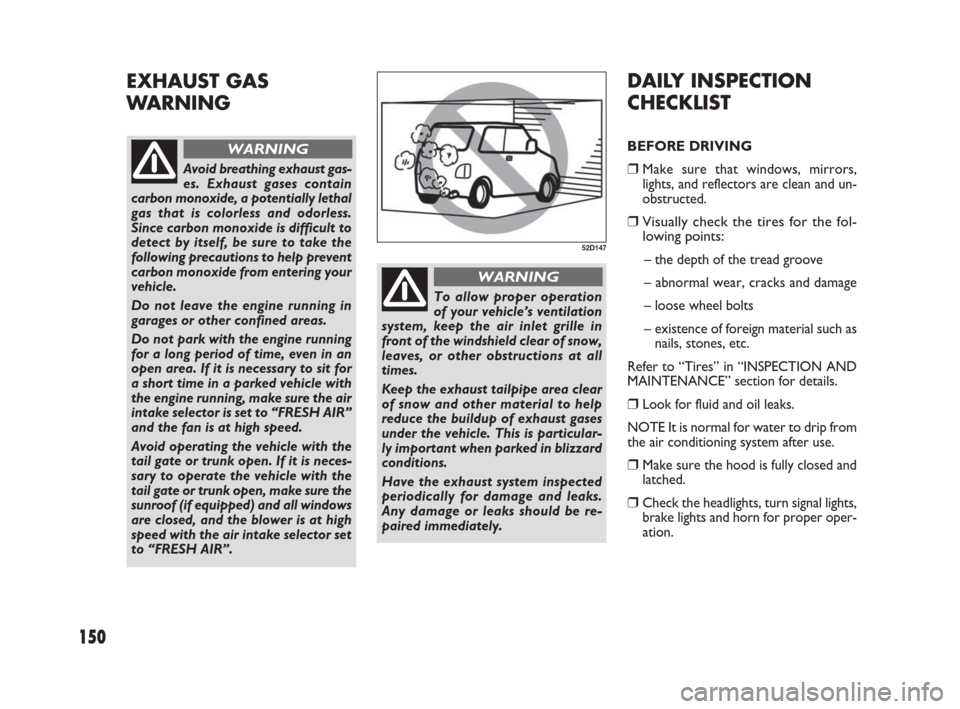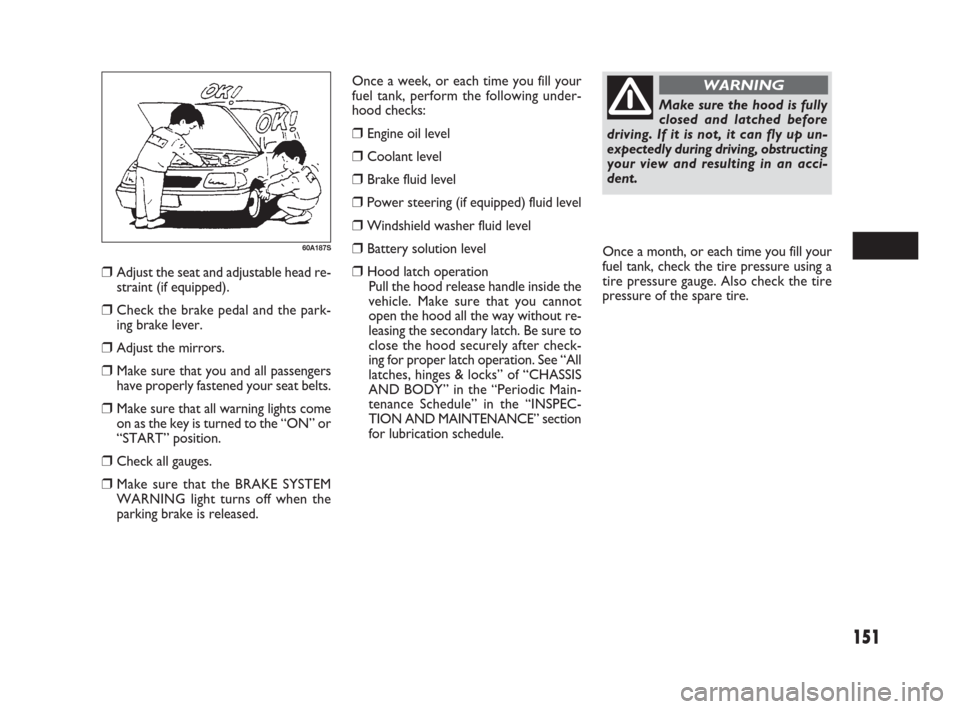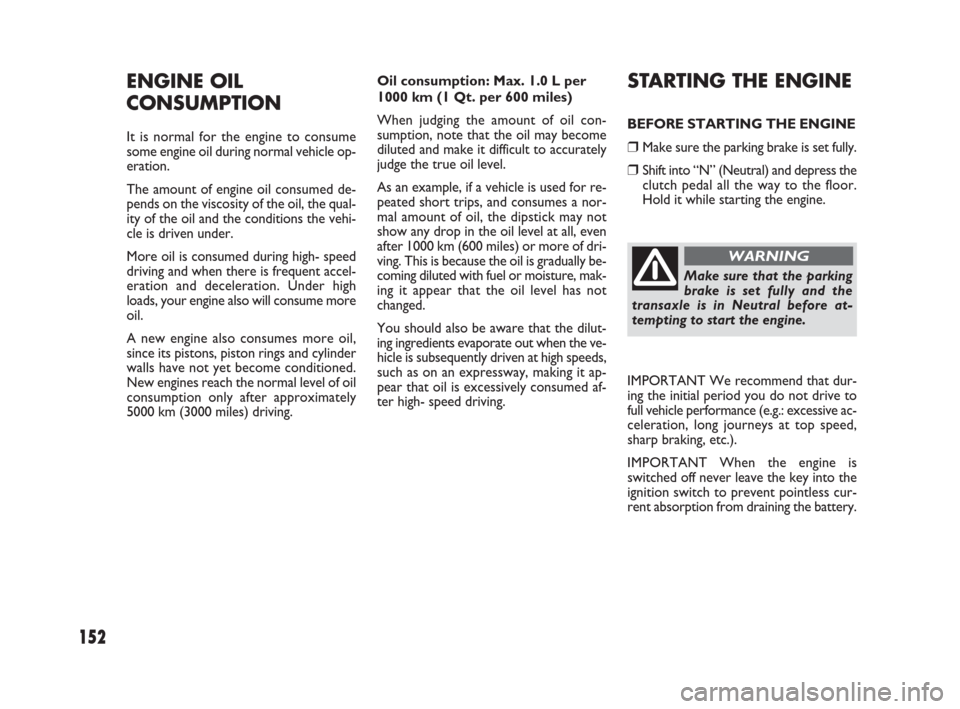Page 145 of 266

144
TIRE CHANGING TOOL
The jack, wheel brace, jack handle are
stowed in the luggage compartment.
To remove the spare tire, turn its bolt
counterclockwise and remove it.
To remove the jack, turn its shaft coun-
terclockwise and pull the jack out of the
storage bracket.
To stow the jack, place it in the storage
bracket and turn the shaft clockwise un-
til the jack is securely held in place.
79J082
79J083
79J084
79J085
The jack shall only be used
for changing wheels on the
vehicle with which it is provided or on
cars of the same model. It must not be
used for other purposes such as for in-
stance raising vehicles of other mod-
els. In no case should it be used for re-
pairs under the vehicle. Incorrect po-
sitioning of the jack may cause the
jacked vehicle to fall. Do not use the
jack for higher capacities than stated
on its label.
WARNING
After using the tire changing
tools, be sure to stow them
securely or they can cause injury if an
accident occurs.
WARNING
79J086
129-148 Fiat16 New GB 27-11-2007 11:27 Pagina 144
Page 146 of 266
145
LUGGAGE RESTRAINT
LOOPS (if equipped)
Four luggage restraint loops are provid-
ed on the luggage compartment floor. An
optional rubber net can be hooked to
these loops to help keep cargo from mov-
ing around in the luggage compartment
during normal driving.
FRONT SEAT BACK
POCKET (if equipped)
This pocket is provided for holding light
and soft things such as gloves, newspapers
or magazines.
60B119Do not put hard or break-
able objects in the pocket. If
an accident occurs, objects such as
bottles, cans, etc. can injure the oc-
cupants in the rear seat.
WARNING
79J087
129-148 Fiat16 New GB 27-11-2007 11:27 Pagina 145
Page 147 of 266
146
LUGGAGE
COMPARTMENT LIGHT
When you open the rear door with the
luggage compartment light switch in the
“ON” position (1), the light comes on and
remains on as long as you keep the rear
door open.
When the luggage compartment light
switch is in the “OFF” position (2), the
light remains off regardless of whether the
rear door is opened or closed.
IMPORTANT Do not leave the rear door
open with the luggage compartment light
switch in the “ON” position for a long
time, or the battery will discharge.
LUGGAGE
COMPARTMENT COVER
(if equipped)
Luggage or other cargo placed in the lug-
gage compartment are hidden from view
by a luggage compartment cover.
79J128
(1) (2)
79J053
Do not carry items on top of
the luggage compartment
cover, even if they are small and light.
Objects on top of the cover could be
thrown about in an accident, causing
injury, or could obstruct the driver’s
rear view.
WARNING
129-148 Fiat16 New GB 27-11-2007 11:27 Pagina 146
Page 149 of 266

148
❒Mount and secure the cargo onto the
roof rack properly according to the in-
structions provided. Be sure to stow
the heaviest items at the bottom and
distribute the cargo as evenly as possi-
ble.
❒Do not carry items so large that they
hang over the bumpers or the sides of
the vehicle, or block your view.
❒Secure the front and rear ends of long
items – such as wood panels, surf-
boards and so forth – to both the front
and rear of the vehicle. You should pro-
tect the painted surfaces of the vehi-
cle from scuffing caused by tie-down
ropes.
❒Check periodically to make sure the
roof rack is securely installed and free
from damage.
❒For vehicles with roof rack anchors,
make sure the anchors are covered
with the caps when not in use.
79J088
79J089
Roof rails
Roof rack anchors
Abrupt maneuvers or failure
to properly secure cargo can
allow the cargo to fly off the vehicle
and hit others, causing personal in-
jury or property damage.
Mount cargo securely and avoid
abrupt maneuvers such as “jackrab-
bit” starts, sharp turns, fast cornering
and sudden braking. Check periodi-
cally to make sure that cargo is se-
curely fastened.
Large, bulky, long, or flat items can
affect vehicle aerodynamics or be
caught by the wind, and can reduce
vehicle control resulting in an acci-
dent and personal injury. Drive cau-
tiously at reduced speed when carry-
ing this type of cargo.
WARNING
129-148 Fiat16 New GB 27-11-2007 11:27 Pagina 148
Page 150 of 266
149
O O
P P
E E
R R
A A
T T
I I
N N
G G
Y Y
O O
U U
R R
V V
E E
H H
I I
C C
L L
E E
60G408
EXHAUST GAS WARNING ............................................. 150
DAILY INSPECTION CHECKLIST .................................. 150
ENGINE OIL CONSUMPTION ....................................... 152
STARTING THE ENGINE ................................................. 152
USING THE TRANSAXLE ................................................. 156
USING THE 2WD/ 4WD SWITCH (if equipped) ........ 157
BRAKING .............................................................................. 160
ELECTRONIC STABILITY PROGRAM (ESP
®)
(if equipped) ........................................................................... 162
RUNNING-IN ....................................................................... 165
CATALYTIC CONVERTER (if equipped)...................... 165
IMPROVING FUEL ECONOMY ...................................... 166
5
149-166 Fiat16 New GB 27-11-2007 11:27 Pagina 149
Page 151 of 266

150
DAILY INSPECTION
CHECKLIST
BEFORE DRIVING
❒Make sure that windows, mirrors,
lights, and reflectors are clean and un-
obstructed.
❒Visually check the tires for the fol-
lowing points:
– the depth of the tread groove
– abnormal wear, cracks and damage
– loose wheel bolts
– existence of foreign material such as
nails, stones, etc.
Refer to “Tires” in “INSPECTION AND
MAINTENANCE” section for details.
❒Look for fluid and oil leaks.
NOTE It is normal for water to drip from
the air conditioning system after use.
❒Make sure the hood is fully closed and
latched.
❒Check the headlights, turn signal lights,
brake lights and horn for proper oper-
ation.
EXHAUST GAS
WARNING
52D147
Avoid breathing exhaust gas-
es. Exhaust gases contain
carbon monoxide, a potentially lethal
gas that is colorless and odorless.
Since carbon monoxide is difficult to
detect by itself, be sure to take the
following precautions to help prevent
carbon monoxide from entering your
vehicle.
Do not leave the engine running in
garages or other confined areas.
Do not park with the engine running
for a long period of time, even in an
open area. If it is necessary to sit for
a short time in a parked vehicle with
the engine running, make sure the air
intake selector is set to “FRESH AIR”
and the fan is at high speed.
Avoid operating the vehicle with the
tail gate or trunk open. If it is neces-
sary to operate the vehicle with the
tail gate or trunk open, make sure the
sunroof (if equipped) and all windows
are closed, and the blower is at high
speed with the air intake selector set
to “FRESH AIR”.
WARNING
To allow proper operation
of your vehicle’s ventilation
system, keep the air inlet grille in
front of the windshield clear of snow,
leaves, or other obstructions at all
times.
Keep the exhaust tailpipe area clear
of snow and other material to help
reduce the buildup of exhaust gases
under the vehicle. This is particular-
ly important when parked in blizzard
conditions.
Have the exhaust system inspected
periodically for damage and leaks.
Any damage or leaks should be re-
paired immediately.
WARNING
149-166 Fiat16 New GB 27-11-2007 11:27 Pagina 150
Page 152 of 266

151
Once a week, or each time you fill your
fuel tank, perform the following under-
hood checks:
❒Engine oil level
❒Coolant level
❒Brake fluid level
❒Power steering (if equipped) fluid level
❒Windshield washer fluid level
❒Battery solution level
❒Hood latch operation
Pull the hood release handle inside the
vehicle. Make sure that you cannot
open the hood all the way without re-
leasing the secondary latch. Be sure to
close the hood securely after check-
ing for proper latch operation. See “All
latches, hinges & locks” of “CHASSIS
AND BODY” in the “Periodic Main-
tenance Schedule” in the “INSPEC-
TION AND MAINTENANCE” section
for lubrication schedule.Once a month, or each time you fill your
fuel tank, check the tire pressure using a
tire pressure gauge. Also check the tire
pressure of the spare tire.❒Adjust the seat and adjustable head re-
straint (if equipped).
❒Check the brake pedal and the park-
ing brake lever.
❒Adjust the mirrors.
❒Make sure that you and all passengers
have properly fastened your seat belts.
❒Make sure that all warning lights come
on as the key is turned to the “ON” or
“START” position.
❒Check all gauges.
❒Make sure that the BRAKE SYSTEM
WARNING light turns off when the
parking brake is released.
60A187S
Make sure the hood is fully
closed and latched before
driving. If it is not, it can fly up un-
expectedly during driving, obstructing
your view and resulting in an acci-
dent.
WARNING
149-166 Fiat16 New GB 27-11-2007 11:27 Pagina 151
Page 153 of 266

152
Oil consumption: Max. 1.0 L per
1000 km (1 Qt. per 600 miles)
When judging the amount of oil con-
sumption, note that the oil may become
diluted and make it difficult to accurately
judge the true oil level.
As an example, if a vehicle is used for re-
peated short trips, and consumes a nor-
mal amount of oil, the dipstick may not
show any drop in the oil level at all, even
after 1000 km (600 miles) or more of dri-
ving. This is because the oil is gradually be-
coming diluted with fuel or moisture, mak-
ing it appear that the oil level has not
changed.
You should also be aware that the dilut-
ing ingredients evaporate out when the ve-
hicle is subsequently driven at high speeds,
such as on an expressway, making it ap-
pear that oil is excessively consumed af-
ter high- speed driving.STARTING THE ENGINE
BEFORE STARTING THE ENGINE
❒Make sure the parking brake is set fully.
❒Shift into “N” (Neutral) and depress the
clutch pedal all the way to the floor.
Hold it while starting the engine.
ENGINE OIL
CONSUMPTION
It is normal for the engine to consume
some engine oil during normal vehicle op-
eration.
The amount of engine oil consumed de-
pends on the viscosity of the oil, the qual-
ity of the oil and the conditions the vehi-
cle is driven under.
More oil is consumed during high- speed
driving and when there is frequent accel-
eration and deceleration. Under high
loads, your engine also will consume more
oil.
A new engine also consumes more oil,
since its pistons, piston rings and cylinder
walls have not yet become conditioned.
New engines reach the normal level of oil
consumption only after approximately
5000 km (3000 miles) driving.
Make sure that the parking
brake is set fully and the
transaxle is in Neutral before at-
tempting to start the engine.
WARNING
IMPORTANT We recommend that dur-
ing the initial period you do not drive to
full vehicle performance (e.g.: excessive ac-
celeration, long journeys at top speed,
sharp braking, etc.).
IMPORTANT When the engine is
switched off never leave the key into the
ignition switch to prevent pointless cur-
rent absorption from draining the battery.
149-166 Fiat16 New GB 27-11-2007 11:27 Pagina 152